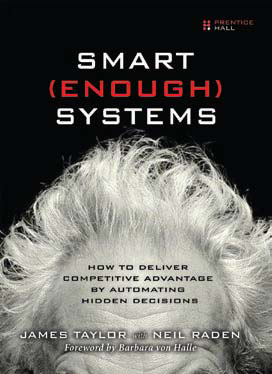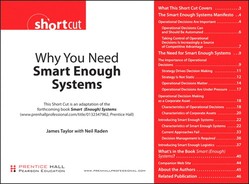Section 4. What’s in the Book Smart (Enough) Systems?
Here’s what people are saying about this book:

“Use this book as your guide to your company of the future. It is time to abandon out-dated hard-wired instincts that no longer lead to organizational survival and success. It is now time to deliver important decisions as agile soft-wired services for the enterprise.”
— Barbara von Halle, from the Forward to the book
“An important book which finally, for the first time, addresses the topic of enterprise decision making not by relying on IT “geekspeak,” but by taking a holistic view of why business people require EDM, why past approaches have failed, and why the changing landscape such as ESOA will make EDM even more critical for the changing business landscape. The authors have an excellent, deep grasp of most concepts, and they present it in a readable, comprehensive, logical way.”
— Roman Bukary, Vice President SAP Labs, LLC
“James Taylor and Neil Raden are on to something important in this book—the tremendous value of improving the large number of routine decisions that are made in organizations every day.”
— Dr. Hugh J. Watson, C. Herman and Mary Virginia Terry Chair of Business Administration, University of Georgia
“This is a very important book. It lays out the agenda for business technology in the new century—nothing less than how to reorganize every aspect of how a company treats its customers.”
— David Raab, President, ClientXClient
“The book is an important contribution to business productivity because it covers the opportunity from both the business executive’s and technologist’s perspectives—essential; if the two sides are to come together in an understanding of what can be done and what’s needed to do it. This should be on every operational executive’s and every CIO’s list of essential reading.” —
John Parkinson, Chairman and Managing Director, ParkWood
Advisors, LLV. Former CTO Capgemini North American Region
Smart (Enough) Systems (www.prenhallprofessional.com/title/0132347962) is about how organizations can deliver systems smart enough to cope with the modern world. Doing so requires a focus on decision making and on automating and managing those decisions. Most organizations struggle with dumb systems and think their choice is between esoteric artificial intelligence from the lab and mindless systems where everything comes down to “peopleware.” Today, people do all the hard work, and computers are left to do only what they do best. Flipping that around is completely feasible: Have people do what they do best, and let computers do the hard work. Organizations can apply proven technology in a new way to get the systems they need.
If you’re interested in how to make your organization function more effectively by improving the behavior of your information systems, this book is for you. You might be a manager, wondering what’s possible with your systems, or an IT professional looking for a framework for thinking about these aspects of information systems. Perhaps you know something about data mining, predictive analytics, optimization, or business rules and are looking for better ways to apply these concepts. You might be in an organization that has never attempted this kind of work or one struggling with getting these technologies out of pilot projects into the mainstream.
The book is divided into two unequal “halves.” The first “half,” directed at both business and technical readers, explains the need for smart enough systems and describes the core concepts behind them. The second half, aimed at more technical readers, describes in more detail the techniques and technologies required and explains how to implement smart enough systems.
We begin with a manifesto—a statement of our beliefs about smart enough systems. Read first, it might seem like a series of assertions. By the time you finish the book, however, it will seem more like a statement of obvious truisms.
The following list summarizes this book’s chapters to give you an overview of what’s covered:
• Chapter 1, “The Need for Smart Enough Systems,” shows how current business megatrends are increasing the importance of operational decisions and forcing organizations to treat operational decision making as a corporate asset. This chapter examines the pressures and difficulties of decision making in the future and the particular challenges of decision making when your systems embody your business more than ever before. This chapter also introduces a theoretical company, SmartEnough Logistics, to illustrate concepts discussed in the book.
• Chapter 2, “Enterprise Decision Management,” introduces a way to build smart enough systems. It explains the enterprise decision management approach to automating decisions and making them into a corporate asset along with the characteristics of operational decision-making problems and finding the hidden decisions in your business. This chapter also discusses how this approach generates a return on investment and presents 11 case studies to show how real organizations have used this approach.
• Chapter 3, “Why Aren’t My Systems Smart Enough Already?” gives you some historical perspective on the development of information technology (IT) and discusses the challenges and opportunities in managing data, building programs, and analyzing businesses.
• Chapter 4, “Core Concepts,” is a transitional chapter that explains the basics of the enterprise decision-management approach: data and analytics, business rules, and adaptive control. Although this chapter is more technical, it should still be accessible to most readers.
• Chapters 5, “Data and Analytics,” 6, “Business Rules,” and 7, “Adaptive Control,” describe these areas in more detail and begin the more technical content of the book. Each chapter contains an architectural overview, definitions of some core concepts, an outline of the critical pieces of technology, and a basic process for using the technologies. You can read the process first and refer back to the concepts and technology or read the basics first and then see how they fit together. Another 11 case studies are presented in these three chapters.
• Chapter 8, “Readiness Assessment,” outlines how to consider your readiness for building smart enough systems in terms of business/IT collaboration, data, analytic understanding, organizational change, and management focus.
• Chapter 9, “Getting There from Here,” lays out the steps for developing true enterprise decision-management competency in four phases: piecemeal adoption, localized decision management, expansion, and steady state enterprise decision management. Another nine case studies are included. The chapter wraps up with a discussion of how SmartEnough Logistics adopted the approach and some thoughts for future developments in enterprise decision management.
• Chapter 10, “EDM and the IT Department,” brings enterprise decision management back to IT and ties its impact to your existing IT architecture. It shows how enterprise decision management complements your existing and future architecture, how it solves a number of issues, and how it enables you to deliver on some critical promises. This chapter includes an overview of how enterprise decision management changes your software development life cycle.
• Chapter 11, “Closing Thoughts,” wraps up the concepts and technologies discussed in the book.
• An appendix, “Decision Yield as a Way to Measure ROI,” is provided to explain a method for assessing return on investment. Few public examples of its use are available, however; so at the moment, it’s more of a good idea than a proven technique.
The case studies used throughout the book are real companies that use enterprise decision management. A couple of case studies are amalgams of several similar companies, and all are anonymous to preserve their privacy.
Product names have been deliberately avoided throughout the book, because it’s the approach—the mindset—that matters. The central issue is not product-specific; it’s about taking charge of the operational decisions that run your business and turning them from a liability into an asset, as expressed in this quote:
“Enterprise decision management (EDM) is emerging as an important discipline, due to an increasing need to automate high-volume decisions across the enterprise and to impart precision, consistency, and agility in the decision-making process.”27
Our goal in this book is to show you why enterprise decision management is important, how to adopt it and how to succeed with it.
Companion Web Site
A companion Web site for the book is available at www.smartenoughsystems.com. This companion site is designed to be a useful ongoing resource to support the book and those using the concepts described in it. The site has an enterprise decision management wiki that supports errata, links, additional materials, and more for the subjects covered in the book. The wiki is open to anyone who registers to participate. News and updates are available through the site’s blog, and additional information is available to help you learn more about the subjects covered—everything from webinars and podcasts to training and books.
